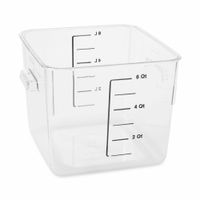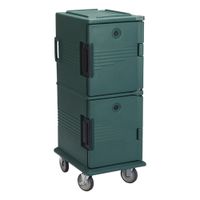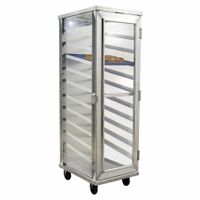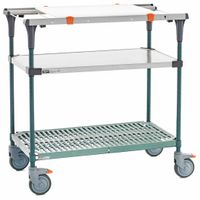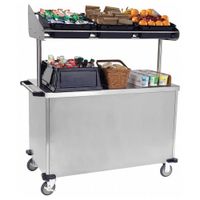Call +(254) 703 030 000 / 751 483 999 / 721 704 777
- Home
- Furnishings Appliances Hospitality
- Tableware Smallwares Food Service Storage Transport
- Food Service Storage Transport
Frequently Asked Questions
What are the best practices for storing food service products?
1. **Temperature Control**: Store perishable items like dairy, meat, and seafood at temperatures below 40°F (4°C) to prevent bacterial growth. Frozen items should be kept at 0°F (-18°C) or lower.
2. **First In, First Out (FIFO)**: Implement FIFO to ensure older stock is used before newer stock, reducing waste and spoilage.
3. **Proper Labeling**: Clearly label all products with the name, date of receipt, and expiration date to facilitate inventory management and ensure food safety.
4. **Separate Storage**: Store raw and cooked foods separately to prevent cross-contamination. Use different shelves or sections for different types of food.
5. **Humidity Control**: Maintain appropriate humidity levels to preserve the quality of fresh produce and prevent spoilage.
6. **Cleanliness**: Regularly clean storage areas to prevent pest infestations and contamination. Ensure all containers and shelves are sanitized.
7. **Use Airtight Containers**: Store dry goods like grains and flour in airtight containers to protect against moisture and pests.
8. **Avoid Overloading**: Do not overcrowd storage areas, as this can impede air circulation and lead to uneven cooling or heating.
9. **Regular Inventory Checks**: Conduct regular inventory checks to monitor stock levels, identify expired items, and adjust orders accordingly.
10. **Proper Ventilation**: Ensure storage areas are well-ventilated to prevent mold growth and maintain air quality.
11. **Pest Control**: Implement pest control measures to protect food from contamination by insects and rodents.
12. **Compliance with Regulations**: Follow local health and safety regulations to ensure food is stored in compliance with legal standards.
How do I choose the right transport cart for my food service needs?
To choose the right transport cart for your food service needs, consider the following factors:
1. **Capacity and Size**: Determine the volume of items you need to transport. Choose a cart that can accommodate your load without being too bulky for your space.
2. **Material**: Select a cart made from materials suitable for your environment. Stainless steel is durable and easy to clean, while plastic is lightweight and resistant to corrosion.
3. **Weight Limit**: Ensure the cart can handle the weight of your items. Check the manufacturer's specifications for maximum load capacity.
4. **Mobility**: Look for carts with swivel casters for easy maneuverability. Consider the floor surface; larger wheels are better for uneven surfaces.
5. **Temperature Control**: If transporting hot or cold items, choose carts with insulated compartments or heated/cooled options to maintain food temperature.
6. **Design and Configuration**: Decide between open or enclosed carts based on your need for visibility and protection. Shelving options can help organize items efficiently.
7. **Ease of Cleaning**: Choose carts with smooth surfaces and removable parts for easy cleaning and sanitation.
8. **Durability and Maintenance**: Consider the cart's build quality and ease of maintenance. Durable carts reduce long-term costs.
9. **Budget**: Balance your needs with your budget. While higher-end models offer more features, ensure they align with your essential requirements.
10. **Compliance and Safety**: Ensure the cart meets health and safety regulations relevant to your area, such as NSF certification for food safety.
11. **Brand and Warranty**: Opt for reputable brands that offer warranties and customer support for peace of mind.
By evaluating these factors, you can select a transport cart that enhances efficiency and meets your food service needs effectively.
What materials are ideal for food storage containers?
Ideal materials for food storage containers include:
1. **Glass**: Non-porous and impermeable, glass containers do not absorb odors or flavors, making them excellent for storing a variety of foods. They are microwave, oven, and dishwasher safe, and do not leach chemicals into food. However, they can be heavy and breakable.
2. **Stainless Steel**: Durable and resistant to corrosion, stainless steel containers are ideal for storing both dry and wet foods. They do not retain odors or stains and are often used for lunch boxes and food transport. They are not microwave-safe but are generally dishwasher safe.
3. **BPA-Free Plastic**: Lightweight and versatile, BPA-free plastic containers are suitable for both dry and liquid storage. They are available in various sizes and shapes, often with airtight seals. However, they may absorb odors and stains over time and should be checked for microwave and dishwasher safety.
4. **Silicone**: Flexible and durable, silicone containers are great for collapsible storage options. They are microwave, oven, and dishwasher safe, and do not leach chemicals. They are ideal for both hot and cold food storage.
5. **Ceramic**: Often used for decorative storage, ceramic containers are non-reactive and do not absorb odors. They are suitable for dry goods and can be used in the oven and microwave. They are heavier and more fragile than other options.
6. **Wood**: Typically used for dry goods, wood containers are aesthetically pleasing and eco-friendly. They are not suitable for wet foods and require proper sealing to prevent moisture absorption.
Each material has its advantages and limitations, and the choice depends on the specific storage needs, such as the type of food, storage duration, and personal preferences regarding sustainability and safety.
How can I maximize space in my kitchen storage?
To maximize space in your kitchen storage, start by decluttering and removing items you rarely use. Organize your kitchen into zones based on function, such as cooking, baking, and food storage, to streamline access and efficiency. Utilize vertical space by installing shelves or hanging racks on walls and inside cabinet doors. Consider using stackable containers for dry goods and clear bins for easy visibility.
Incorporate pull-out shelves or drawers in cabinets to access items at the back easily. Use tension rods to create dividers for cutting boards and baking sheets. Install a pegboard on a wall to hang pots, pans, and utensils, freeing up cabinet space. Opt for multi-functional furniture, like an island with built-in storage or a fold-down table.
Maximize drawer space with organizers or dividers to keep utensils and tools neatly arranged. Use lazy Susans in corner cabinets to make items more accessible. Consider magnetic strips for knives and spice jars to save counter and drawer space.
For under-sink storage, use stackable bins or tiered shelves to organize cleaning supplies. Hang hooks or small baskets on the inside of cabinet doors for additional storage.
Finally, regularly reassess your kitchen items and storage solutions to ensure they meet your needs and adjust as necessary.
What are the benefits of using portable prep worktables?
Portable prep worktables offer several benefits, enhancing efficiency and flexibility in various settings:
1. **Mobility**: These tables can be easily moved to different locations, allowing for dynamic workspace arrangements and adaptability to changing needs.
2. **Space Optimization**: They help maximize available space, especially in small or crowded environments, by providing additional work surfaces that can be relocated or stored when not in use.
3. **Versatility**: Portable worktables can be used for a variety of tasks, from food preparation in kitchens to assembly work in industrial settings, making them a versatile addition to any workspace.
4. **Cost-Effectiveness**: Investing in portable tables can be more economical than installing permanent fixtures, especially in temporary or evolving workspaces.
5. **Ease of Cleaning and Maintenance**: Many portable worktables are designed with materials that are easy to clean and maintain, ensuring hygiene and durability.
6. **Customization**: They often come with adjustable features, such as height settings or additional attachments, allowing users to tailor the table to specific tasks or ergonomic needs.
7. **Increased Productivity**: By providing additional workspace and flexibility, portable prep worktables can help streamline processes and improve workflow efficiency.
8. **Durability**: Made from robust materials, these tables are designed to withstand frequent movement and heavy use, ensuring long-term reliability.
9. **Safety**: Many models include features like locking wheels or stable bases to prevent accidents, enhancing workplace safety.
10. **Convenience**: Quick setup and breakdown make portable worktables convenient for events, catering, or temporary projects, reducing setup time and effort.
Overall, portable prep worktables are a practical solution for enhancing workspace functionality and adaptability.
How do I maintain and clean food service transport equipment?
To maintain and clean food service transport equipment, follow these steps:
1. **Regular Inspection**: Frequently check for wear and tear, loose parts, or any damage. Address issues immediately to prevent further damage.
2. **Cleaning Schedule**: Establish a routine cleaning schedule based on usage frequency. Daily cleaning is recommended for high-use equipment.
3. **Pre-Cleaning Preparation**: Before cleaning, unplug electrical equipment and remove any detachable parts. Empty containers of food residues.
4. **Use Appropriate Cleaning Agents**: Select cleaning agents suitable for the material of the equipment. Avoid harsh chemicals that can damage surfaces or leave harmful residues.
5. **Manual Cleaning**: For non-electric parts, use warm soapy water and a soft brush or cloth to scrub surfaces. Pay special attention to corners and crevices where food particles can accumulate.
6. **Sanitization**: After cleaning, sanitize surfaces using a food-safe sanitizer to kill bacteria and prevent contamination. Follow the manufacturer's instructions for dilution and contact time.
7. **Rinse and Dry**: Thoroughly rinse off cleaning agents and sanitizers with clean water. Dry all parts completely to prevent rust and mold growth.
8. **Reassemble and Test**: Once dry, reassemble the equipment. Test to ensure it functions correctly.
9. **Storage**: Store equipment in a clean, dry area to prevent contamination and damage. Ensure it is covered or sealed when not in use.
10. **Documentation**: Keep records of maintenance and cleaning activities. This helps in tracking the equipment's condition and scheduling future maintenance.
11. **Training**: Train staff on proper cleaning techniques and the importance of maintaining equipment to ensure compliance and prolong equipment life.
By following these steps, you ensure the longevity and efficiency of your food service transport equipment while maintaining hygiene standards.
What are the regulations for food storage and transport in food service environments?
Food storage and transport regulations in food service environments are designed to ensure food safety and prevent contamination. Key regulations include:
1. **Temperature Control**: Perishable foods must be stored at safe temperatures. Refrigerated foods should be kept at or below 40°F (4°C), while frozen foods should be stored at 0°F (-18°C) or lower. Hot foods must be maintained at 140°F (60°C) or above during transport.
2. **Cross-Contamination Prevention**: Foods must be stored in a manner that prevents cross-contamination. Raw meats should be stored below ready-to-eat foods, and separate utensils and containers should be used for different food types.
3. **Proper Labeling**: All stored and transported foods must be properly labeled with contents, preparation dates, and expiration dates to ensure proper stock rotation and traceability.
4. **Sanitation and Hygiene**: Storage and transport equipment, such as containers and vehicles, must be regularly cleaned and sanitized. Personnel handling food must adhere to strict hygiene practices, including handwashing and wearing appropriate protective gear.
5. **Pest Control**: Storage areas must be kept clean and free from pests. Regular inspections and pest control measures should be implemented to prevent infestations.
6. **Packaging**: Foods must be packaged in materials that are food-safe and protect against contamination and spoilage during transport.
7. **Regulatory Compliance**: Food service environments must comply with local, state, and federal regulations, such as those set by the FDA and USDA in the United States, which may include specific guidelines for different types of food products.
8. **Documentation and Record-Keeping**: Accurate records of food storage and transport conditions must be maintained to ensure compliance and facilitate traceability in case of a food safety incident.
